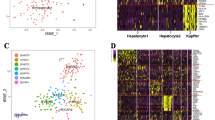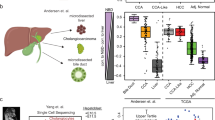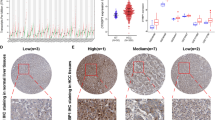Abstract
Identification of key drivers and new therapeutic targets is important given the poor prognosis for hepatocellular carcinoma (HCC) patients, particularly those ineligible for surgical resection or liver transplant. However, the approach to identify such driver genes is facing significant challenges due to the genomically heterogenous nature of HCC. Here we tested whether the integrative genomic profiling of a well-defined HCC subset that is classified by an extreme EpCAM+ AFP+ gene expression signature and associated with poor prognosis, all attributes of a stem cell-like phenotype, could uncover survival-related driver genes in HCC. Following transcriptomic analysis of the well-defined HCC cases, a Gene Set Enrichment Analysis coupled with genomic copy number alteration assessment revealed that YY1-associated protein 1 (YY1AP1) is a critical oncoprotein specifically activated in EpCAM+ AFP+ HCC. YY1AP1 silencing eliminates oncogene addiction by altering the chromatin landscape and triggering massive apoptosis in vitro and tumor suppression in vivo. YY1AP1 expression promotes HCC proliferation and is required for the maintenance of stem cell features. We revealed that YY1AP1 cooperates with YY1 to alter the chromatin landscape and activate transcription of stemness regulators. Thus YY1AP1 may serve as a key molecular target for EpCAM+ AFP+ HCC subtype. Our results demonstrate the feasibility and power of a new strategy by utilizing well-defined patient samples and integrative genomics to uncover critical pathways linked to HCC subtypes with prognostic impact.
This is a preview of subscription content, access via your institution
Access options
Subscribe to this journal
Receive 50 print issues and online access
$259.00 per year
only $5.18 per issue
Buy this article
- Purchase on Springer Link
- Instant access to full article PDF
Prices may be subject to local taxes which are calculated during checkout







Similar content being viewed by others
References
Jemal A, Bray F, Center MM, Ferlay J, Ward E, Forman D . Global cancer statistics. CA Cancer J Clin 2011; 61: 69–90.
Laurent-Puig P, Legoix P, Bluteau O, Belghiti J, Franco D, Binot F et al. Genetic alterations associated with hepatocellular carcinomas define distinct pathways of hepatocarcinogenesis. Gastroenterology 2001; 120: 1763–1773.
Ye QH, Qin LX, Forgues M, He P, Kim JW, Peng AC et al. Predicting hepatitis B virus-positive metastatic hepatocellular carcinomas using gene expression profiling and supervised machine learning. Nat Med 2003; 9: 416–423.
Lee JS, Chu IS, Heo J, Calvisi DF, Sun Z, Roskams T et al. Classification and prediction of survival in hepatocellular carcinoma by gene expression profiling. Hepatology 2004; 40: 667–676.
Lee JS, Heo J, Libbrecht L, Chu IS, Kaposi-Novak P, Calvisi DF et al. A novel prognostic subtype of human hepatocellular carcinoma derived from hepatic progenitor cells. Nat Med 2006; 12: 410–416.
Budhu A, Forgues M, Ye QH, Jia LH, He P, Zanetti KA et al. Prediction of venous metastases, recurrence and prognosis in hepatocellular carcinoma based on a unique immune response signature of the liver microenvironment. Cancer Cell 2006; 10: 99–111.
Boyault S, Rickman DS, de Reynies A, Balabaud C, Rebouissou S, Jeannot E et al. Transcriptome classification of HCC is related to gene alterations and to new therapeutic targets. Hepatology 2007; 45: 42–52.
Yamashita T, Forgues M, Wang W, Kim JW, Ye Q, Jia H et al. EpCAM and alpha-fetoprotein expression defines novel prognostic subtypes of hepatocellular carcinoma. Cancer Res 2008; 68: 1451–1461.
Hoshida Y, Nijman SM, Kobayashi M, Chan JA, Brunet JP, Chiang DY et al. Integrative transcriptome analysis reveals common molecular subclasses of human hepatocellular carcinoma. Cancer Res 2009; 69: 7385–7392.
Zhou XD, Tang ZY, Yang BH, Lin ZY, Ma ZC, Ye SL et al. Experience of 1000 patients who underwent hepatectomy for small hepatocellular carcinoma. Cancer 2001; 91: 1479–1486.
Llovet JM, Ricci S, Mazzaferro V, Hilgard P, Gane E, Blanc JF et al. Sorafenib in advanced hepatocellular carcinoma. N Engl J Med 2008; 359: 378–390.
Siegel R, Naishadham D, Jemal A . Cancer statistics, 2013. CA Cancer J Clin 2013; 63: 11–30.
Hanahan D, Weinberg RA . Hallmarks of cancer: the next generation. Cell 2011; 144: 646–674.
Stephens PJ, Tarpey PS, Davies H, Van LP, Greenman C, Wedge DC et al. The landscape of cancer genes and mutational processes in breast cancer. Nature 2012; 486: 400–404.
Guichard C, Amaddeo G, Imbeaud S, Ladeiro Y, Pelletier L, Maad IB et al. Integrated analysis of somatic mutations and focal copy-number changes identifies key genes and pathways in hepatocellular carcinoma. Nat Genet 2012; 44: 694–698.
Ji J, Wang XW . Clinical implications of cancer stem cell biology in hepatocellular carcinoma. Semin Oncol 2012; 39: 461–472.
Yamashita T, Wang XW . Cancer stem cells in the development of liver cancer. J Clin Invest 2013; 123: 1911–1918.
Ji J, Yamashita T, Budhu A, Forgues M, Jia HL, Li C et al. Identification of microRNA-181 by genome-wide screening as a critical player in EpCAM-positive hepatic cancer stem cells. Hepatology 2009; 50: 472–480.
Yamashita T, Budhu A, Forgues M, Wang XW . Activation of hepatic stem cell marker EpCAM by Wnt-ß-catenin signaling in hepatocellular carcinoma. Cancer Res 2007; 67: 10831–10839.
Yamashita T, Ji J, Budhu A, Forgues M, Yang W, Wang HY et al. EpCAM-positive hepatocellular carcinoma cells are tumor-initiating cells with stem/progenitor cell features. Gastroenterology 2009; 136: 1012–1024.
Roessler S, Long EL, Budhu A, Chen Y, Zhao X, Ji J et al. Integrative genomic identification of genes on 8p associated with hepatocellular carcinoma progression and patient survival. Gastroenterology 2012; 142: 957–966.
Kuryshev VY, Vorobyov E, Zink D, Schmitz J, Rozhdestvensky TS, Munstermann E et al. An anthropoid-specific segmental duplication on human chromosome 1q22. Genomics 2006; 88: 143–151.
Guo M, House MG, Hooker C, Han Y, Heath E, Gabrielson E et al. Promoter hypermethylation of resected bronchial margins: a field defect of changes? Clin Cancer Res 2004; 10: 5131–5136.
Yang EB, Tang WY, Zhang K, Cheng LY, Mack PO . Norcantharidin inhibits growth of human HepG2 cell-transplanted tumor in nude mice and prolongs host survival. Cancer Lett 1997; 117: 93–98.
Zhang K, Loong SL, Connor S, Yu SW, Tan SY, Ng RT et al. Complete tumor response following intratumoral 32P BioSilicon on human hepatocellular and pancreatic carcinoma xenografts in nude mice. Clin Cancer Res 2005; 11: 7532–7537.
Wang CY, Liang YJ, Lin YS, Shih HM, Jou YS, Yu WC . YY1AP, a novel co-activator of YY1. J Biol Chem 2004; 279: 17750–17755.
Cuddapah S, Schones DE, Cui K, Roh TY, Barski A, Wei G et al. Genomic profiling of HMGN1 reveals an association with chromatin at regulatory regions. Mol Cell Biol 2011; 31: 700–709.
Sun ZW, Allis CD . Ubiquitination of histone H2B regulates H3 methylation and gene silencing in yeast. Nature 2002; 418: 104–108.
Laribee RN, Krogan NJ, Xiao T, Shibata Y, Hughes TR, Greenblatt JF et al. BUR kinase selectively regulates H3 K4 trimethylation and H2B ubiquitylation through recruitment of the PAF elongation complex. Curr Biol 2005; 15: 1487–1493.
Lee JS, Shukla A, Schneider J, Swanson SK, Washburn MP, Florens L et al. Histone crosstalk between H2B monoubiquitination and H3 methylation mediated by COMPASS. Cell 2007; 131: 1084–1096.
Kim J, Guermah M, McGinty RK, Lee JS, Tang Z, Milne TA et al. RAD6-mediated transcription-coupled H2B ubiquitylation directly stimulates H3K4 methylation in human cells. Cell 2009; 137: 459–471.
Kizer KO, Phatnani HP, Shibata Y, Hall H, Greenleaf AL, Strahl BD . A novel domain in Set2 mediates RNA polymerase II interaction and couples histone H3 K36 methylation with transcript elongation. Mol Cell Biol 2005; 25: 3305–3316.
Rotili D, Mai A . Targeting histone demethylases: a new avenue for the fight against cancer. Genes Cancer 2011; 2: 663–679.
Stratton MR, Campbell PJ, Futreal PA . The cancer genome. Nature 2009; 458: 719–724.
Beroukhim R, Mermel CH, Porter D, Wei G, Raychaudhuri S, Donovan J et al. The landscape of somatic copy-number alteration across human cancers. Nature 2010; 463: 899–905.
Forbes SA, Bindal N, Bamford S, Cole C, Kok CY, Beare D et al. COSMIC: mining complete cancer genomes in the Catalogue of Somatic Mutations in Cancer. Nucleic Acids Res 2011; 39: D945–D950.
Gerlinger M, Rowan AJ, Horswell S, Larkin J, Endesfelder D, Gronroos E et al. Intratumor heterogeneity and branched evolution revealed by multiregion sequencing. N Engl J Med 2012; 366: 883–892.
Cancer Genome Atlas Network. Comprehensive molecular characterization of human colon and rectal cancer. Nature 2012; 487: 330–337.
Cancer Genome Atlas Research Network. Comprehensive genomic characterization of squamous cell lung cancers. Nature 2012; 489: 519–525.
Oishi N, Kumar MR, Roessler S, Ji J, Forgues M, Budhu A et al. Transcriptomic profiling reveals hepatic stem-like gene signatures and interplay of miR-200c and epithelial-mesenchymal transition in intrahepatic cholangiocarcinoma. Hepatology 2012; 56: 1792–1803.
Budhu A, Roessler S, Zhao X, Yu Z, Forgues M, Ji J et al. Integrated metabolite and gene expression profiles identify lipid biomarkers associated with progression of hepatocellular carcinoma and patient outcomes. Gastroenterology 2013; 144: 1066–1075.
Weinstein IB . Cancer. Addiction to oncogenes—the Achilles heal of cancer. Science 2002; 297: 63–64.
Sankpal NV, Willman MW, Fleming TP, Mayfield JD, Gillanders WE . Transcriptional repression of epithelial cell adhesion molecule contributes to p53 control of breast cancer invasion. Cancer Res 2009; 69: 753–757.
Roessler S, Jia HL, Budhu A, Forgues M, Ye QH, Lee JS et al. A unique metastasis gene signature enables prediction of tumor relapse in early-stage hepatocellular carcinoma patients. Cancer Res 2010; 70: 10202–10212.
Acknowledgements
We thank Dr Curtis Harris for critical reading of the manuscript, Dr Zheng-Gang Liu for advice on apoptosis study, Dominic Esposito at the Advanced Technology Program of SAIC-Frederick, Inc., for the help in designing the Tet-C2 inducible construct and Liver Tissue Cell Distribution System (LTCDS) at the University of Minnesota (Minneapolis, MN, USA) for generous donation of normal liver specimens. We also thank Karen Yarrick for the bibliographic assistance. This work was supported by the Intramural Research Grants of the Center for Cancer Research and the US National Cancer Institute Z01 BC 010313, Z01 BC 010877 and Z01 BC 010876.
Author information
Authors and Affiliations
Corresponding author
Ethics declarations
Competing interests
The authors declare no conflict of interest.
Additional information
Supplementary Information accompanies this paper on the Oncogene website
Supplementary information
Rights and permissions
About this article
Cite this article
Zhao, X., Parpart, S., Takai, A. et al. Integrative genomics identifies YY1AP1 as an oncogenic driver in EpCAM+ AFP+ hepatocellular carcinoma. Oncogene 34, 5095–5104 (2015). https://doi.org/10.1038/onc.2014.438
Received:
Revised:
Accepted:
Published:
Issue Date:
DOI: https://doi.org/10.1038/onc.2014.438
This article is cited by
-
Clinical relevance of molecular characteristics in Burkitt lymphoma differs according to age
Nature Communications (2022)
-
The pattern of gene copy number alteration (CNAs) in hepatocellular carcinoma: an in silico analysis
Molecular Cytogenetics (2021)
-
Roles Played by YY1 in Embryonic, Adult and Cancer Stem Cells
Stem Cell Reviews and Reports (2021)
-
Enrichment of cancer stem cells via β-catenin contributing to the tumorigenesis of hepatocellular carcinoma
BMC Cancer (2018)



